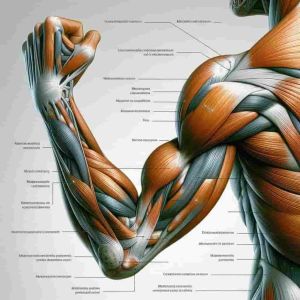Muscle Atrophy

Muscle Atrophy is a medical condition characterized by the wasting or loss of muscle tissue. It is a serious condition that can significantly affect an individual’s quality of life and ability to perform daily activities. Muscle atrophy can occur due to various reasons, including physical inactivity, nerve damage, malnutrition, aging, and genetic disorders. This condition not only impacts muscle strength and mass but also affects metabolic health and overall physical functioning.
Causes of Muscle Atrophy[edit | edit source]
Understanding the underlying causes is crucial for the effective treatment and management of muscle atrophy:
- Disuse Atrophy:
- Physical Inactivity: Prolonged bed rest, immobilization due to injury or illness, and a sedentary lifestyle can lead to muscle atrophy. The lack of muscle use leads to a decrease in muscle mass and strength.
- Microgravity: Astronauts often experience muscle atrophy during extended space missions due to the lack of gravitational forces, which reduces the load on muscles.
- Neurogenic Atrophy:
- Nerve Damage: Conditions like Amyotrophic Lateral Sclerosis (ALS), Multiple Sclerosis (MS), and spinal cord injuries can lead to neurogenic atrophy. Damage to the nerves that control muscles impairs the ability of muscles to contract, resulting in muscle wasting.
- Peripheral Neuropathy: This condition, often caused by diabetes, can lead to damage of peripheral nerves, resulting in muscle weakness and atrophy.
- Malnutrition:
- Protein Deficiency: Adequate protein intake is crucial for muscle maintenance and growth. Protein deficiency can lead to muscle atrophy as the body starts breaking down muscle tissues to meet its protein requirements.
- General Malnutrition: Overall insufficient nutrition, including deficiencies in essential vitamins and minerals, can contribute to muscle wasting.
- Sarcopenia:
- Age-Related Muscle Loss: With aging, there is a natural decline in muscle mass and strength, a condition known as sarcopenia. Factors contributing to sarcopenia include hormonal changes, reduced physical activity, and inadequate nutrition.
- Hormonal Changes: The decline in growth hormone, testosterone, and other anabolic hormones with age can contribute to the reduction in muscle mass and strength.
- Genetic Disorders:
- Muscular Dystrophy: This group of genetic conditions causes progressive muscle weakness and degeneration.
- Spinal Muscular Atrophy (SMA): A genetic disorder characterized by the loss of motor neurons, leading to progressive muscle wasting and weakness.
Symptoms of Muscle Atrophy[edit | edit source]
The symptoms of muscle atrophy can vary depending on the underlying cause and severity. Common symptoms include:
- Visible Muscle Wasting: Noticeable reduction in muscle size and tone.
- Weakness: Difficulty performing tasks that require strength, such as lifting objects or climbing stairs.
- Fatigue: Increased tiredness and reduced endurance.
- Balance Problems: Difficulty maintaining balance or frequent falls.
- Fine Motor Skill Impairment: Challenges in tasks requiring dexterity, such as writing or buttoning a shirt.
Diagnosis of Muscle Atrophy[edit | edit source]
Diagnosis involves a combination of medical history review, physical examination, and diagnostic tests:
- Physical Examination: Doctors assess muscle mass, strength, and tone.
- Electromyography (EMG): Measures electrical activity in muscles to identify nerve or muscle disorders.
- Imaging Tests: MRI and CT scans provide detailed views of muscle tissue and help in identifying the extent of muscle loss.
- Blood Tests: Help identify underlying conditions such as malnutrition or hormonal imbalances.
- Nerve Conduction Studies: Assess the function of nerves connected to muscles.
Treatment and Management of Muscle Atrophy[edit | edit source]
Treatment of muscle atrophy involves addressing the underlying cause and implementing strategies to improve muscle mass and strength. Key approaches include:
- Physical Therapy:
- Exercise Programs: Tailored exercise regimens designed to improve muscle strength, endurance, and flexibility. Weight-bearing and resistance exercises are particularly effective.
- Occupational Therapy: Helps individuals with daily tasks and improves their quality of life.
- Nutritional Support:
- Protein-Rich Diet: Ensuring adequate protein intake is essential for muscle repair and growth. High-protein foods include lean meats, dairy products, legumes, and nuts.
- Supplements: Vitamins and minerals that support muscle health, such as vitamin D, calcium, and omega-3 fatty acids.
- Medical Interventions:
- Medications: In cases of neurogenic atrophy, medications like corticosteroids can help manage symptoms and slow the progression of muscle loss.
- Surgical Interventions: In some cases, surgical procedures may be necessary to relieve nerve compression or repair damaged nerves.
- Assistive Devices:
- Braces and Splints: Provide support to weakened muscles and joints, helping to prevent further deterioration and improve mobility.
- Mobility Aids: Devices such as walkers, canes, or wheelchairs can assist with movement and reduce the risk of falls.
- Alternative Therapies:
- Electrical Stimulation: Involves using electrical impulses to stimulate muscle contraction, which can help maintain muscle mass and strength in some individuals.
- Massage Therapy: Improves circulation, reduces muscle stiffness, and promotes relaxation.
Prognosis and Long-Term Management[edit | edit source]
The prognosis for muscle atrophy varies based on the underlying cause and the timeliness of intervention. Early diagnosis and intervention can significantly improve outcomes. Long-term management strategies include:
- Regular Physical Activity: Engaging in regular exercise to maintain muscle mass and strength.
- Balanced Nutrition: Ensuring a diet rich in essential nutrients to support overall health.
- Monitoring and Support: Regular follow-up with healthcare providers to monitor progress and adjust treatment plans as needed.
Conclusion[edit | edit source]
Muscle atrophy is a condition that requires comprehensive management to improve quality of life and functional ability. Understanding the causes, symptoms, diagnosis, and treatment options is essential for effective management. By maintaining an active lifestyle, proper nutrition, and seeking timely medical intervention, individuals can manage muscle atrophy and improve their overall well-being.